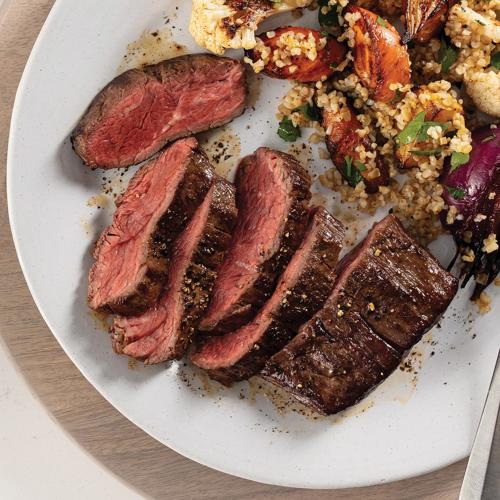When most people bite into a mouthwatering steak, they don’t often take the time to wonder why it tastes so good or to consider its journey from the pasture to their plate. That’s why many people are confused when they hear the term “grass-finished beef.” Isn’t all beef grass-finished and treated the same before it’s cooked? The answer, it turns out, is a little more complicated!
At Omaha Steaks, we’re committed to delivering more than just gourmet food – we’re committed to delivering the highest level of authenticity to our customers. Above all, we’re honest and real about our products and think it’s vital that, as America’s Original Butcher and authority on beef since 1917, we ensure our customers understand every part of our world-famous experience. So, join us as we take a closer look at the conversation around “grass-finished” and “grain-finished” beef.

What is Grass-Finished Beef?
Just as the name implies, grass-finished beef is beef that originates from cattle that have been exclusively fed grass until they reach “market weight.” This diet requires a longer period of time before they’re ready to go to market and produces beef that is more expensive, leaner in texture, lower in calories, and more pastoral- and gamey-flavored.
What is Grain-Finished Beef?
Grain-finished beef is not to be confused with grass-finished beef. Just like grass-finished beef, grain-finished cattle start by feeding exclusively on grass. This diet continues until they’re around 4-6 months from reaching their target market weight, at which point they’re transitioned to a nutrient-rich grain-based diet while they “finish” growing, which is why the process is called “grain-finished.” This beef is more affordable, goes to market three times faster, and features a fat content that enhances flavor and tenderness.

Grass-Finished Beef:
- Lower in total fat – including monounsaturated fat – and calories
- More nutrient-rich beef, specifically in vitamins A and E and Omega-3s
- Contains twice as much of the healthy fatty acid conjugated linoleic acid
- Leaner texture and gamey flavor
- Takes three times longer to go to market, creating a strain on the environment and increasing cost
- Its low-fat content makes it easier to overcook and tougher to eat

Grain-Finished Beef:
- Fat content creates rich marbling
- Marbling creates a more beefy, flavorful, and tender steak
- Fed hearty, nutrient-rich grain
- Contains the same amount of Omega-6 polyunsaturated fats as grass-finished beef
- Goes to market three times faster, and the shorter length of pasture-grazing time decreases environmental strain
- Approximately 95% of U.S. cattle are grain-finished1

Grain-Finished Beef:
- Fat content creates rich marbling
- Marbling creates a more beefy, flavorful, and tender steak
- Fed hearty, nutrient-rich grain
- Contains the same amount of Omega-6 polyunsaturated fats as grass-finished beef
- Goes to market three times faster, and the shorter length of pasture-grazing time decreases environmental strain
- Approximately 95% of U.S. cattle are grain-finished1

Grass-Finished Beef:
- Lower in total fat – including monounsaturated fat – and calories
- More nutrient-rich beef, specifically in vitamins A and E and Omega-3s
- Contains twice as much of the healthy fatty acid conjugated linoleic acid
- Leaner texture and gamey flavor
- Takes three times longer to go to market, creating a strain on the environment and increasing cost
- Its low-fat content makes it easier to overcook and tougher to eat
 Which is Better?
Which is Better?
When it comes to food, “better” really comes down to personal preference and lifestyle needs. While some people may prefer to cut calories on the grill, want an additional source of specific vitamins, or simply prefer the strong and earthy flavor of gamey beef, the majority of people and industry experts overwhelmingly prefer grain-finished beef.
“As a fourth-generation beef industry expert with 29 years of professional experience, I have been around and tasted a lot of different types of beef,” shares Omaha Steaks Procurement & Product Development Senior Category Manager BJ Bezousek. “For my money, I will always choose beef that has been grain-finished because I know it’s going to have that rich, buttery, and authentically beefy flavor that my whole family and I love.”
“In my opinion,” Bezousek continues, “grass-finished beef typically tastes overly vegetal and metallic, which is not the flavor most people seek in their steak and burgers. That’s why I only eat beef raised on a pasture and grain-finished, the way that four generations of my family have preferred.”
Does Omaha Steaks Sell Grass-Finished Beef?
Omaha Steaks beef is predominantly grain-finished, but we understand some may prefer the unique experience of a 100% grass-finished steak or burger. Above all, satisfying every single one of our customers is our highest priority, which is why we also offer several grass-fed options, all backed by our unconditional 100% guarantee.
Take the Taste Test for Yourself!
If you’re unsure whether grass-finished or grain-finished beef is right for you, you can try both worry-free with our 100% satisfaction guarantee that, no matter which you prefer, your Omaha Steaks beef will be the best you’ve ever tasted.
1https://extension.psu.edu/grass-fed-beef-production

Steaks
Shop steaks by cut, texture, flavor — whatever you prefer! We’ve got something for everyone.

